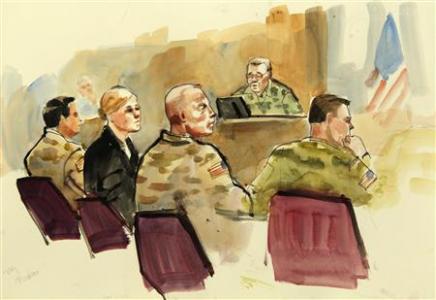(Note strong language in the 11th paragraph)
By Bill Rigby
(Reuters) – A U.S. Army soldier charged with killing 16 Afghan civilians in a drunken rampage in March sat quietly in a military courtroom on Monday as prosecutors outlined their case, accusing him of two murderous forays from his barracks into nearby villages.

Prosecutor Jay Morse said he would present evidence proving “chilling premeditation” on the part of Staff Sergeant Robert Bales, a decorated veteran of four combat tours in Iraq and Afghanistan who is accused of the mass killings.
The shootings of mostly women and children in Afghanistan’s Kandahar province marked the worst civilian slaughter by U.S. forces since the Vietnam War and eroded already strained U.S.-Afghan ties after over a decade of conflict in the country.
Bales faces 16 counts of premeditated murder and six counts of attempted murder, as well as charges of assault and wrongfully possessing and using steroids and alcohol while deployed. If convicted, he could face the death penalty.
The hearing at Joint Base Lewis-McChord in Washington state is expected to last two weeks and include witness testimony in Afghanistan carried by live video, including villagers and Afghan soldiers.
At the end, military commanders will decide whether there is sufficient evidence to refer the case for trial by court-martial.
Bales, dressed in camouflage Army fatigues, his head shaven, embraced his wife in court before the hearing began. He then sat silently watching the proceedings from the defense table as Morse summarized the prosecution’s account of the events of March 11.
According to Morse, Bales had been drinking and paid a brief visit to the room of a fellow soldier before he left the Army post, called Camp Belambay, and went to a village where he committed the first set of slayings.
Morse said Bales then returned to the camp, told some others what he had done and left again, moving on to a different village and committing additional killings. He called Bales’ actions “deliberate, methodical.”
DESCRIBED AS WEARING CAPE
The prosecution then showed a video shot by night-vision camera from a surveillance balloon over the camp, showing a figure they identified as Bales walking back to the post wearing what they described as a cape.
He is seen being confronted by three soldiers, who order him to drop his weapons and take him into custody as he is heard saying, “Are you fucking kidding me?”
Prosecutors said Bales had been armed with an M-1 rifle, a pistol and a grenade launcher during the killings.
Bales, who is not expected to testify during the so-called Article 32 hearing, had been confined at a military prison in Kansas from March until he was moved in October to Lewis-McChord, where his infantry regiment was based.
John Henry Browne, Bales’ civilian lawyer, has suggested that Bales may not have acted alone and may be suffering from post-traumatic stress disorder.
Browne told Reuters last month that he and an Army prosecutor planned to question five to 15 Afghan villagers and military personnel as key witnesses from Kandahar Air Field.
Bales also has two military defense counselors, Major Gregory Malson and Captain Matthew Aeisi. Malson represented Army Sergeant William Kreutzer, who was sentenced to life in prison three years ago for killing an officer and wounding 18 U.S. soldiers in a 1995 shooting spree.
Separately, Bales is subject to a review of his mental fitness to stand trial, often referred to as a “sanity board.” The Army has not disclosed the status of that evaluation.
The March shooting highlighted discipline problems among U.S. soldiers from Lewis-McChord, which was also the home base of five enlisted men from the former 5th Stryker Brigade charged with premeditated murder in connection with three killings of unarmed Afghan civilians in 2010.
Four of the men were convicted or pleaded guilty in court-martial proceedings to murder or manslaughter charges and were sentenced to prison. Charges against the fifth were dropped.
In August, U.S. Defense Secretary Leon Panetta directed a panel of experts to assess whether reforms were needed in the way the military justice system handles crimes committed by U.S. forces against civilians in combat zones.
(Additional reporting by Laura L. Myers; Editing by Steve Gorman, Paul Simao and Cynthia Osterman)





